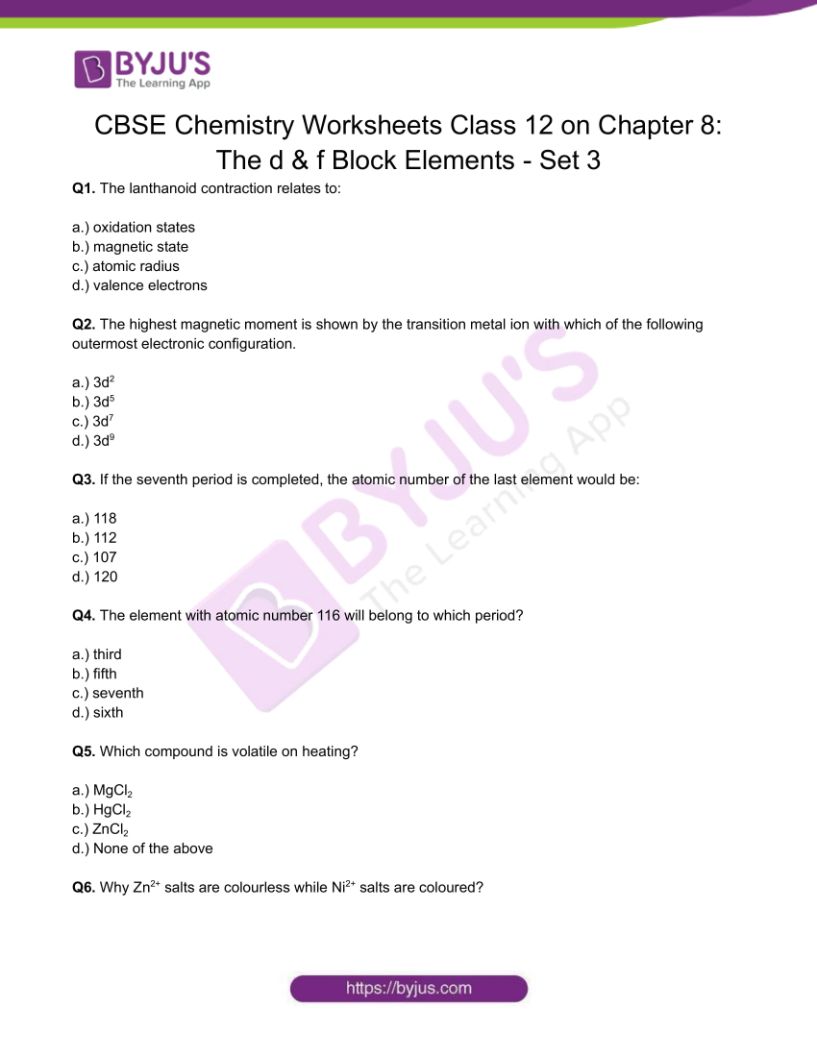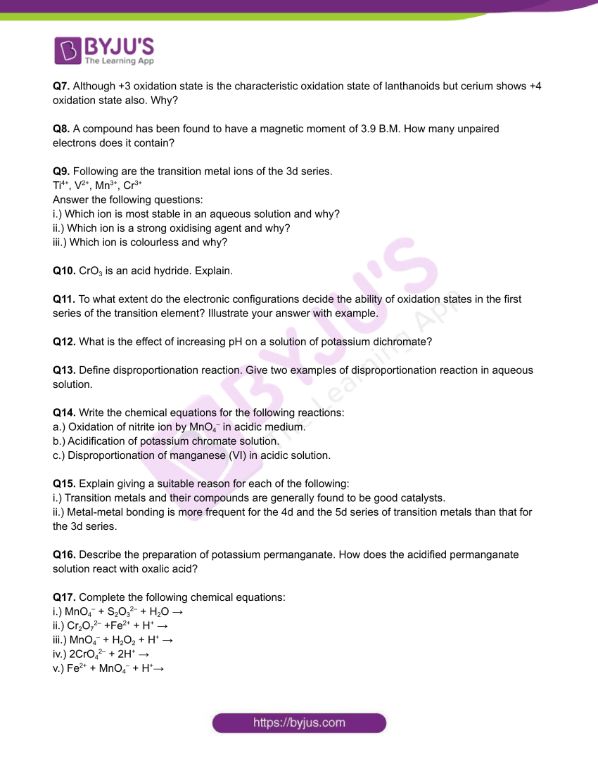The elements in the middle of the periodic table, from Group 3 to 12, are referred to as d-block elements. The name d-blocks comes from the fact that the final electron enters the d-orbital of the penultimate shell. These are frequently referred to as transition elements because their properties fall somewhere between highly reactive metallic s-block elements and nonmetallic p-block elements. The d block contains four series that correspond to the filling of 3d, 4d, 5d, or 6d orbitals.
- First transition series or 3d series ( Sc, Ti, V, Cr, Mn, Fe, Co, Ni, Cu, Zn)
- Second transition series or 4d series (Y, Zr, Nb, Mo, Tc, Ru, Rh, Pd, Ag, Cd)
- Third transition series or 5d series (La, Hf, Ta, W, Re, Os, Ir, Pt, Au, Hg)
- Fourth transition series or 6d series- incomplete.
F block elements, on the other hand, are found outside at the bottom of the periodic table. The name f-blocks comes from the fact that the last electron enters the f-orbital of the anti-penultimate shell. These are also referred to as inner transition elements. The f block contains two series, which correspond to the filling of 4f and 5f orbitals.
- Lanthanide series or 4f series (Ce, Pr, Nd, Pm, Sm, Eu, Gd, Tb, Dy, Ho, Er, Tm , Yb)
- Actinide series of 5f series ( Th, Pa, U, Np, Pu, Am, Cm, Bk, Cf, Es, Fm, Md, Mo)
Download Class 12 Chemistry Worksheet Chapter 8 The d & f Block Elements PDF – Set 3
CBSE Class 12 Chemistry Chapter 8 The d & f Block Elements Worksheet – Set 3
Q1. The lanthanoid contraction relates to:
a.) oxidation states
b.) magnetic state
c.) atomic radius
d.) valence electrons
Q2. The highest magnetic moment is shown by the transition metal ion with which of the following outermost electronic configuration.
a.) 3d2
b.) 3d5
c.) 3d7
d.) 3d9
Q3. If the seventh period is completed, the atomic number of the last element would be:
a.) 118
b.) 112
c.) 107
d.) 120
Q4. The element with atomic number 116 will belong to which period?
a.) third
b.) fifth
c.) seventh
d.) sixth
Q5. Which compound is volatile on heating?
a.) MgCl2
b.) HgCl2
c.) ZnCl2
d.) None of the above
Q6. Why Zn2+ salts are colourless while Ni2+ salts are coloured?
Q7. Although +3 oxidation state is the characteristic oxidation state of lanthanoids but cerium shows +4 oxidation state also. Why?
Q8. A compound has been found to have a magnetic moment of 3.9 B.M. How many unpaired electrons does it contain?
Q9. Following are the transition metal ions of the 3d series.
Ti4+, V2+, Mn3+, Cr3+
Answer the following questions:
i.) Which ion is most stable in an aqueous solution and why?
ii.) Which ion is a strong oxidising agent and why?
iii.) Which ion is colourless and why?
Q10. CrO3 is an acid hydride. Explain.
Q11. To what extent do the electronic configurations decide the ability of oxidation states in the first series of the transition element? Illustrate your answer with example.
Q12. What is the effect of increasing pH on a solution of potassium dichromate?
Q13. Define disproportionation reaction. Give two examples of disproportionation reaction in aqueous solution.
Q14. Write the chemical equations for the following reactions:
a.) Oxidation of nitrite ion by MnO4– in acidic medium.
b.) Acidification of potassium chromate solution.
c.) Disproportionation of manganese (VI) in acidic solution.
Q15. Explain giving a suitable reason for each of the following:
i.) Transition metals and their compounds are generally found to be good catalysts.
ii.) Metal-metal bonding is more frequent for the 4d and the 5d series of transition metals than that for the 3d series.
Q16. Describe the preparation of potassium permanganate. How does the acidified permanganate solution react with oxalic acid?
Q17. Complete the following chemical equations:
i.) MnO4– + S2O32– + H2O →
ii.) Cr2O72– +Fe2+ + H+ →
iii.) MnO4– + H2O2 + H+ →
iv.) 2CrO42– + 2H+ →
v.) Fe2+ + MnO4– + H+→
Q18. a.) i.) How is the variability in oxidation states of transition metals different from that of the p-block elements?
ii.) Out of Cu+ and Cu2+, which ion is unstable in an aqueous solution and why?
iii.) The orange colour of Cr2O72– ion changes to yellow when treated with an alkali. Why?
b.) The chemistry of actinoids is complicated as compared to lanthanoids. Give two reasons.
Q19. How would you account for the irregular variation of ionization enthalpies (first and second) in the first series of the transition elements?
Q20. Give reasons-
i.) Transition metals have high melting points.
ii.) Second and third transition series have similar radii.
iii.) Second ionization is difficult for Cu and Cr whereas it is easy for Zn.
iv.) Most of the transition elements are paramagnetic.
v.) Transition elements form alloys.
Download PDF to access answers of Chemistry Worksheet for Class 12 Chemistry Chapter 8: The d & f Block Elements set – 3.
Download PDF




Comments